Mathematics and Art

Current MAM Home Page || Previous MAWs/MAMs || Current Activities

Fractals Bounding Negative Space
Fractal Stone Prints
For me, the major development in twentieth century sculpture was the opening up of the solid form and the creation of space as in the work of Barbara Hepworth and Henry Moore. I generally begin a sculpture by carving out a space. Like most sculptors, I accidently discovered that a shortcut to forming space was to break a stone and then separate the pieces to form a space. One then has the natural fractal geometry of the broken stone. Benoit Mandelbrot told me "that the word fractal came from fracture, as in the edge of broken granite, rather then from fraction as some people think." This statement definitely influenced me since I had been working with broken granite and was led to a technique for making prints. I begin with a planar shape of one-inch thick polished granite. On the rough side I draw a pattern of straight lines along which I tap with a chisel to split the granite along the lines. This results in a fractal division of the planar shape into several pieces. I separate them to form space between pieces and I may also remove some pieces to form spaces. Black ink is rolled on the polished surface of the stones and a sheet of thin Japanese paper is placed on the inked stones. When pressure is applied with a barren, the ink permeates the paper. The lower surface of the paper on the stones has a solid black image, which was the original intent. It came as a surprise that the ink permeating the paper produced an interesting "grey-black" image on the upper surface that is visible when the print is being made. By applying pressure with a burnishing tool along the broken edges, these fractal edges show up as black on the upper surface due to the ink permeating the upper surface of the paper. Thus one actually obtains a two-sided print, where the lower side is black and the upper side is a grey-black monoprint controlled by the pressure of the barren and the burnishing tool. One can also fold one side onto the other to obtain an image combining both sides. One can also use colored inks, which has opened up many more possibilities.
Here are four examples, and a picture of a fractal sculpture with two prints, one black and the reverse side with the ink permeating the paper. River and Streams, Cliff Face, and Flamenco are two-sided prints.
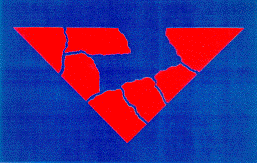
Pas de Deux |
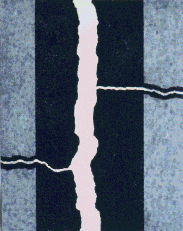
River and Streams |
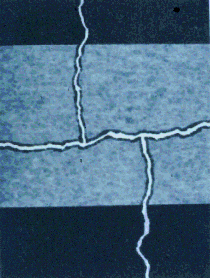
Cliff Face |
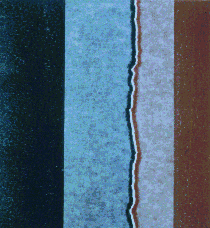
Flamenco |
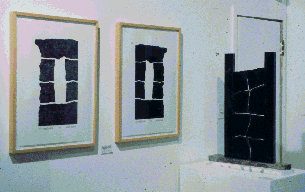
A fractal sculpture and print pair |
|
I consider the fractal geometry of broken granite to be a visually exciting geometry in contrast to straight line Euclidean geometry. I have control over the pattern of straight lines that I draw on the back of the stone along which I tap with a chisel to break the stone. However, I have no control over the way the stone breaks to form natural fractals, which introduces a certain randomness. In a print such as River and Streams, I call attention to the fact that the fractal geometry of broken granite and the fractal geometry of rivers and streams is the same. In the print the river is represented by the wider spacing of the stones and the streams correspond to the narrow spacing. Part of the process is selecting appropriate spacings. In some prints I just like working with the natural fractal geometry for its own sake without any underlying meaning.
The print Pas de Deux refers to the outer straight line geometry of the triangle supporting the interesting inner fractal geometry analogous to a male dancer supporting his female partner while she performs interesting movements in a pas de deux. The fractal triangle is also on point analogous to a ballet dancer being on point.
I have also made some abstract fractal torsos that are done by breaking a stone, removing some inner pieces, and then reassembling the remaining pieces. Here the fractal geometry reflects the psychological process of coming apart and putting yourself back together. The inner space may have a positive or negative interpretation. It could represent getting rid of something that bothered you or it could represent the loss of someone. In any case, only fractal geometry can convey this psychological process of breaking apart. Here is where fractal geometry reflects nature in psychology.
| Mathematics Awareness Month is sponsored each year by the Joint Policy Board for Mathematics to recognize the importance of mathematics through written materials and an accompanying poster that highlight mathematical developments and applications in a particular area. |